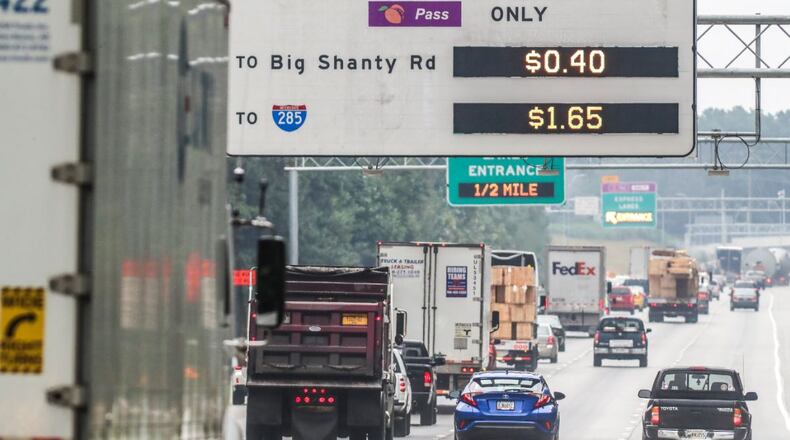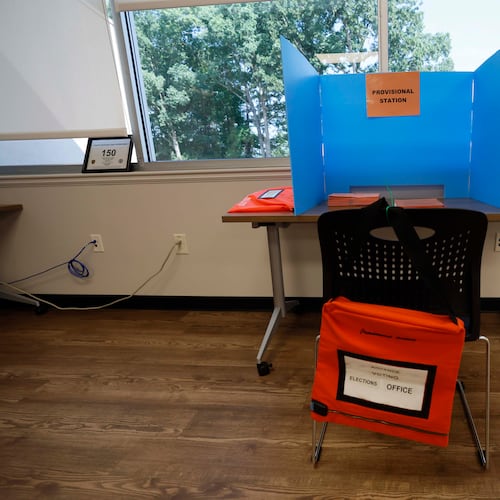Georgia is betting billions of dollars that toll lanes can be a big part of the solution to metro Atlanta’s traffic mess, and early evidence suggests that gamble is paying off.
Traffic is zipping along for those willing to pay by the mile. Motorists in the free lanes are also benefiting, though not as much as the paying customers. And the new lanes have been a boon for many bus riders, who have been arriving early to their destinations.
But the future may not look quite so rosy. The gains for motorists in the free lanes are likely to diminish over time. And though early studies show they’re not just “Lexus lanes” for the rich, the toll lanes may become too pricey in the long run for some people, transportation experts say.
What's more, with metro Atlanta adding tens of thousands of new residents a year, traffic is likely to get worse, even with the new lanes.
“That’s the future in areas like Atlanta,” said Ginger Goodin, a senior research engineer at the Texas A&M Transportation Institute. “You cannot keep up with that demand.”
Such caveats have not dampened Georgia's enthusiasm for toll lanes. The state has already spent nearly $1.3 billion to build 67 miles of toll lanes on metro Atlanta highways. The lanes cover 25 miles of I-85 northeast of Atlanta, 12 miles on I-75 to the south and 30 miles on I-75 and I-575 northwest of the city.
The biggest investment is yet to come. Georgia will spend an additional $7.6 billion in coming years to build lanes on the top half of the Perimeter and along Ga. 400. And that's just the construction cost. The state will spend billions more on interest to finance the construction and on maintenance and operation of the lanes.
State officials say the toll lanes — they call them “managed” or “express” lanes — are a better investment than free lanes.
“A managed lane has the potential to be more efficient,” said Chris Tomlinson, the executive director of the State Road and Tollway Authority. “You’re managing demand.”
Better than free lanes?
It works like this. The state charges motorists with a Peach Pass a minimum of 10 cents a mile to use the lanes, but the price rises as traffic increases. The idea is to raise the price high enough to discourage some motorists from using them — keeping traffic in the lanes moving at least 45 mph.
That may not seem very fast, but at the peak of rush hour, when traffic is stop-and-go, plenty of metro Atlanta residents are willing to pay to keep moving.
Goodin said research from across the country shows that adding managed lanes is more effective at alleviating traffic congestion than building more free lanes. That’s because new free lanes tend to fill up quickly as motorists who previously avoided congested highways return.
Researchers call that “latent demand.” To avoid crowded highways, motorists take alternate routes or travel at off-peak hours or simply stay home. But when the new lanes open, they return to the highway — and in short order traffic is just as bad as it was before.
“If you put in a lane and you just open it up to everybody, it will fill up and you still have congestion,” Goodin said. But she said traffic in new managed lanes can keep moving.
Research also shows managed lanes can carry more vehicles per hour at rush hour than the free lanes because traffic in the free lanes is crawling. That’s what Georgia Tech professor Randall Guensler found when he studied the I-85 express lanes, which opened in 2011.
“A properly priced managed lane not only operates at 45-plus mph, the lane actually carries more traffic in vehicles per hour than the adjacent congested lanes,” Guensler said.
Who benefits?
The lanes have been a boon to those willing to pay.
According to the State Road and Tollway Authority, rush-hour traffic in recent months on the I-85 and I-75 South Metro express lanes averaged about 10 mph faster than traffic in the adjacent free lanes. Traffic moved a whopping 18 mph faster on the Northwest Corridor lanes.
With thousands of motorists opting to pay a toll, they have freed up space in the regular lanes, which have also seen traffic speeds increase.
Transit passengers also have benefited because buses can travel in the toll lanes for free. In 2015, the SRTA found that 26 percent of the people using the I-85 lanes during the morning commute were riding in buses.
Indeed, the express lanes network could become the backbone of an extensive bus rapid transit system — short-circuiting conventional arguments over whether metro Atlanta needs more roads or more transit.
“It’s not either-or. Metro Atlanta needs both solutions,” Georgia Department of Transportation Commissioner Russell McMurry said. “The express lanes provide opportunity for express lane transit.”
Still, not everyone has embraced the new lanes. Many residents dismiss them as "Lexus lanes" for the rich.
So far, those concerns appear to be overblown. Guensler’s research has shown motorists of all income levels use the I-85 lanes, though the most frequent users tend to have higher incomes.
“Managed lanes are not Lexus lanes, they are Honda Accord, Toyota Camry and Ford F-150 lanes,” he said.
The average toll drivers paid for the I-85 lanes was just $3.44 in April. Average tolls are even lower on the Northwest Corridor ($2.32) and the South Metro lanes (91 cents).
But Goodin said keeping the lanes accessible to low-income motorists may become harder over time. As the region grows and more people crowd onto its highways, the price needed to keep traffic moving in the toll lanes will rise.
One cautionary example: A one-way toll for a section of managed lanes in Washington, D.C., topped $46 last year.
“You’re going to see prices going up,” Goodin said. “And then you’ll see prices that are really out of range for people of different income levels.”
Last year the SRTA eliminated the maximum toll on I-85. Tolls have topped $15 at times since then.
Tomlinson, the SRTA’s executive director, doesn’t believe tolls will become unaffordable in Atlanta any time soon. But he’s already thinking of ways to keep them manageable. For example, in the future the agency could charge more for single-occupancy vehicles than for three-person carpools or vanpools, which already ride for free on the I-85 lanes.
And he noted anyone can use the lanes without paying a toll if they ride a bus.
Still, Tomlinson acknowledged the toll lanes won’t solve all of Atlanta’s traffic problems.
“When we’re dealing with urban congestion, we’re going to have to deploy multiple solutions,” he said. “I’m not sure any one solution would adequately address it.”
Want more information?
The Georgia Department of Transportation has scheduled a series of June meetings where the public can get information about its plans for toll lanes along the east side of I-285. Here’s the schedule:
- 4:30 to 7:30 p.m. June 18 at the Clarkston First Baptist Church Gymnasium, 3999 Church St., Clarkston.
- 4:30 to 7:30 p.m. June 20 at the Peace Baptist Church Annex, 3996 Covington Highway, Decatur.
- 11:30 a.m. to 2:30 p.m. and 4:30 to 7:30 p.m. June 25 at the Rehoboth Baptist Church Fellowship Hall, 2997 Lawrenceville Highway, Tucker.
- 4:30 to 7:30 p.m. June 27 at the DoubleTree Hotel Northlake Atlanta, 4156 LaVista Road, Atlanta.
About the Author
Keep Reading
The Latest
Featured




